Does Bluetooth Use Wi-Fi or Mobile Data?
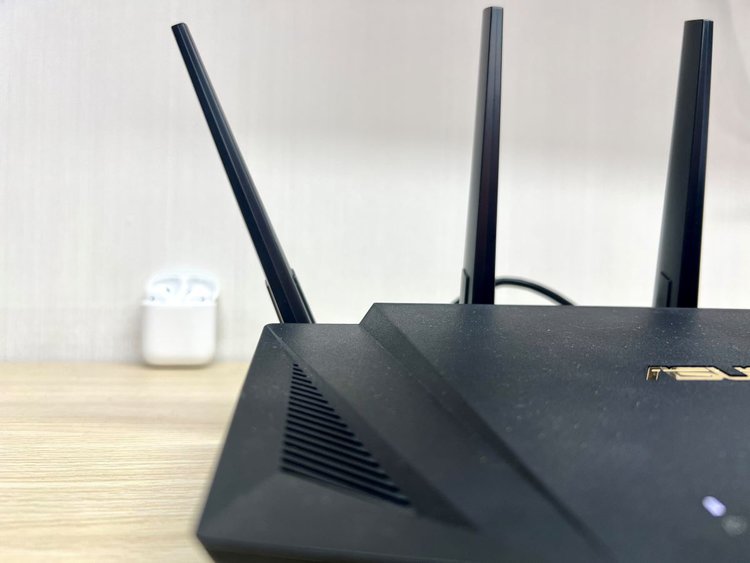
- Bluetooth operates independently of Wi-Fi and cellular data. Bluetooth uses 2.4 GHz radio waves for short-range communication up to 300 feet without the internet.
- Bluetooth tethering allows the sharing of internet data but doesn’t consume the data itself; it acts merely as a bridge.
- To enable Bluetooth tethering: On Android, go to Settings > Network & internet > Hotspot & tethering > Bluetooth tethering; On iPhone, Settings > Personal Hotspot > Allow Others to Join.
Are you wondering if Bluetooth can use data or Wi-Fi?
Rest easy, as this concise guide clarifies the ins and outs of Bluetooth’s relationship with other wireless protocols, ensuring your queries on its data usage are comprehensively addressed.
Quick Navigation
Bluetooth vs. Wi-Fi vs. Cellular Data
Here is a quick overview of the three wireless technology standards:
| Bluetooth | Wi-Fi | Cellular (Data) | |
| Definition | Short-range and wireless network protocol, use radio waves to transmit signals | Short-range and wireless network protocol, use radio waves to transmit signals | Wide-range and wireless communication, use radio waves to transmit |
| Main Purposes | Transfer data through its network | – Used to connect to the Internet (WAN)
– Local area networking of devices (LAN) |
Use to connect to the Internet |
| Radio Frequencies (RF) | 2.4 GHz | 2.4/5/6 GHz | 450 – 2100 MHz |
| Range | Up to 300 feet | Up to 300 feet (2.4 GHz) | Up to 45 miles |
| Data Transmission Rate | 50 Mbps (Bluetooth 5.0, 5.1, 5.2) | 40 Gbps (Wi-Fi 7) | Up to 20 Gbps (5G) |
Note: Though Bluetooth and Wi-Fi are short-range and wireless, they are two discrete network protocols serving different requirements.
Does Bluetooth Use Wi-Fi or Cellular Data?
No, Bluetooth doesn’t use Wi-Fi or cellular data since it doesn’t require the internet to function.
Bluetooth, Wi-Fi, and cellular data are separate protocols and independent of each other.
The transmitter and receiver Bluetooth uses differ from the ones your smartphone employs to receive 5G, 4G, or 3G internet.
Bluetooth employs 2.4 GHz frequency radio waves to send information over distances up to 300 feet (or more) theoretically based on the electromagnetic environment and obstacles there are.
At times, the frequencies at which they work, such as 2.4 GHz, could cause them to collide. But that’s the only point of any real conflict.
Your desktop and Bluetooth keyboard or mouse talk to each other without the internet. Even if your computer is offline, you shall have no problems transmitting keystrokes or mouse clicks to it wirelessly.
However, listening to songs or watching movies online with a Bluetooth headset requires an internet connection. Note that the activity requires the internet, not the Bluetooth device itself.
Perhaps, that is where this confusion regarding Bluetooth requiring Wi-Fi or phone data arises.
How About Sharing the Internet Through Bluetooth? Does It Use Internet Data?
No, Bluetooth doesn’t use internet data, whether connected to another Bluetooth device or when sharing internet data between two devices.
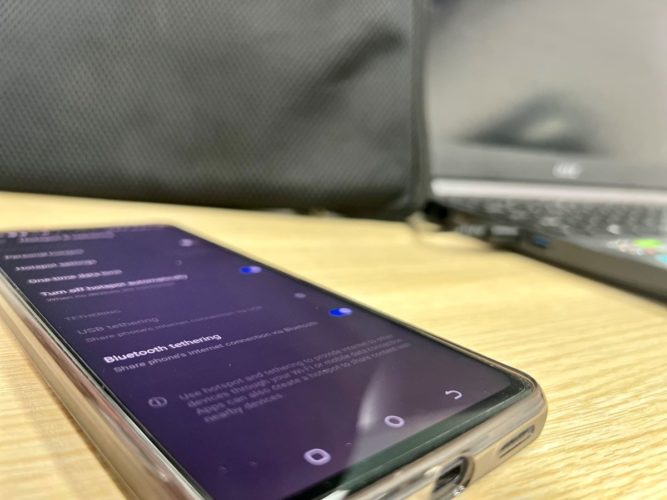
You may share the internet from your phone to your laptop using the Bluetooth tethering feature.
It is a technique commonly used to connect your phone or laptop to the internet without turning on its Wi-Fi capability.
Bluetooth bridges the two devices and transports internet data between them. And it doesn’t require any internet to set up or facilitate that link.
What is Bluetooth Tethering? And How Does It Work?
Bluetooth tethering is essentially sharing a device’s internet connection with another device leveraging Bluetooth.
Your phone or tablet functions as the modem in a typical tethering setup. The recipient device (your laptop or phone) connects to the origin device via Bluetooth to borrow its internet.
The process to enable Bluetooth tethering and connect to another device will vary based on the devices and their operating systems.
The internet speeds won’t be as speedy or reliable as Ethernet or Wi-Fi tethering methods. Also, Bluetooth tethering could result in greater power consumption, causing the batteries on both devices to lose charge quicker than usual.
Sharing data through Bluetooth comes in handy when there’s no Wi-Fi network or if the Wi-Fi function on your device is not working properly and connecting devices via a cable is non-feasible.
Bluetooth tethering also enables sharing the internet without disclosing your mobile hotspot password.
By the way, the number of devices you can share the internet to via Bluetooth tethering is limited to the maximum number of devices your Android device or iPhone can connect to simultaneously via Bluetooth.
But because the internet speeds via Bluetooth are sub-par, don’t expect snappy internet performance on connected devices.
The method to share internet data through Bluetooth tethering varies with devices and their operating systems. Below are the instructions to enable the feature and link devices on different platforms.
Android to Windows
- Turn on your phone’s Wi-Fi or cellular data.
- Enable Bluetooth functionality on your PC. To turn on Bluetooth on your Windows computer, follow these instructions:
- Open the Settings app and click on Bluetooth & devices on the left pane.
- Turn on the switch to the right of the Bluetooth option.
- Connect the two devices via Bluetooth. Accept the pairing request on both devices.
- Turn on Wi-Fi or phone data on your phone and enable Bluetooth tethering. Here are the steps to do that:
- Open Settings.
- Tap Network & internet and choose Hotspot & tethering.
- Toggle on the switch next to Bluetooth tethering.
- Open the Bluetooth & devices on your computer.
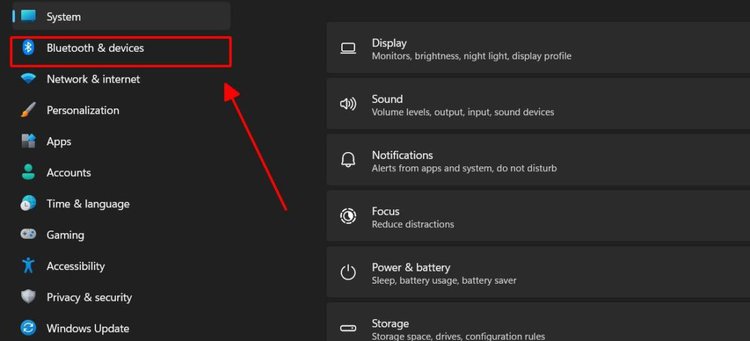
- Head to Devices.
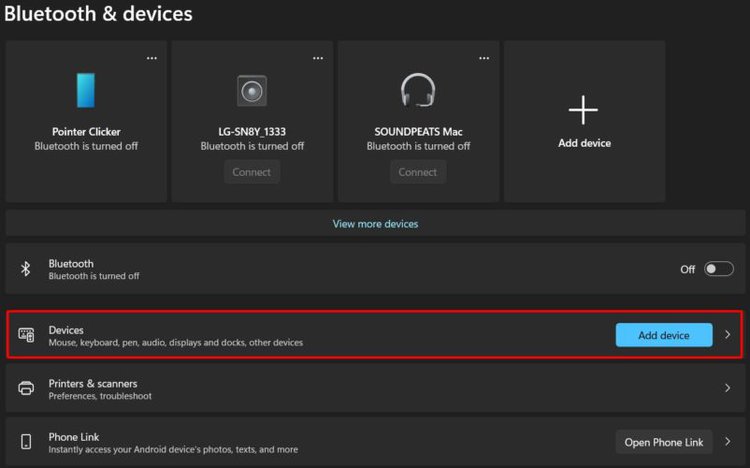
- Click on Devices and Printers or More devices and printer settings.
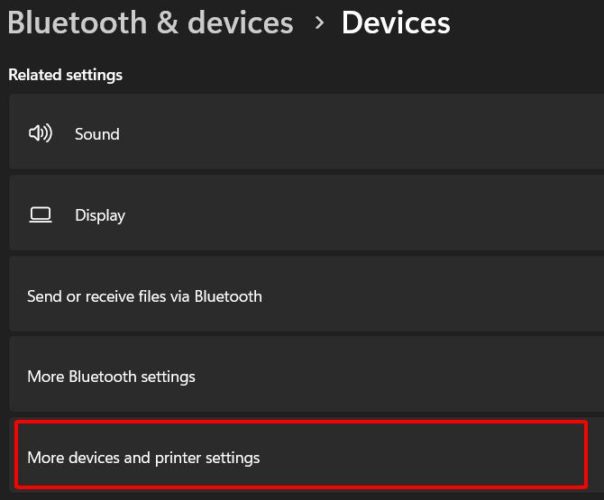
- Right-click on your mobile device. Select Connect using and then Access point. The Bluetooth tethering should now be active.
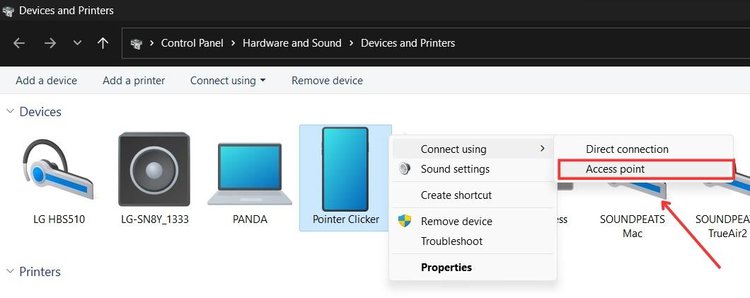
By the way, if clicking on Devices and Printers takes you to the new Windows 11 Settings interface, run the command “shell:::{A8A91A66-3A7D-4424-8D24-04E180695C7A}” in the Run dialog box (Ctrl + R to open it) to access the old interface.
Alternatively, head to the system tray and right-click the Bluetooth sign. Click Join a personal area network.
In the next window, select your phone, click Connect using, and select Access point.
You can also right-click the icon representing your phone to summon the above connection options.
Android to Android
- Enable Wi-Fi or cellular data on your sharing Android smartphone.
- Enable Bluetooth on both devices.
- Connect the two devices by accepting the pairing request.
- Enable Bluetooth tethering on the first phone or the device sharing its internet.
- Open Bluetooth Settings on both devices and prepare them for pairing.
- On the first device, tap the second device’s name to let it use the data via Bluetooth tethering.
The recipient device should now be able to use the source device’s internet via Bluetooth.
Here is a video showing how to share phone data from one Samsung device to another via Bluetooth tethering:
The Bluetooth tethering and internet sharing function should work similarly between Android and iPhone.
Only the steps to enable Bluetooth will be different on your iPhone. Also, you must enable “Personal Hotspot” on the Apple phone. More on that is below.
iPhone to Windows/Mac
- Enable Wi-Fi or cellular data on your iPhone.
- Turn on Bluetooth on your iPhone and computer and pair the two with each other. If it’s your first time turning on Bluetooth on your iPhone, here are the steps:
- Open your iPhone’s Settings app.
- Tap Bluetooth and toggle on the switch to the right of Bluetooth. From the list of devices presented below, tap on the one you want to connect to—in this case, it’s your computer.
You can also turn on your iPhone’s Bluetooth by swiping up from below while on the phone’s home screen or any app.
Tap the Bluetooth icon. If it turns blue after you tap, Bluetooth is turned on. If it’s blue already, it means your Bluetooth was on to begin with.
You can also turn on Bluetooth by waking up Siri and asking her to enable the feature.
- Once your iPhone and laptop are paired via Bluetooth, access “Personal Hotspot” on your iPhone. On the Settings app, tap Personal Hotspot and enable the Allow Others to Join option.
Disable Wi-Fi on your computer and connect it to your iPhone via Bluetooth to confirm internet access through tethering.
Here is a video demonstrating the above and how to fiddle with your Windows PC’s Control Panel settings:
Follow the instructions above to turn on Bluetooth on your Windows device. To enable Bluetooth on your Mac, do the following:
- Click on the Apple logo in the top left of your Mac’s home screen.
- Click on System Preferences and then click on the Bluetooth icon.
- Click the Turn Bluetooth On button to turn on Bluetooth.
Conclusion
To conclude, Bluetooth doesn’t use or require Wi-Fi or phone data to function.
And because it doesn’t depend on the nearest cell tower to transmit data, you are not charged a fee to use the technology.
Depending on your internet usage, you may incur costs or exhaust your internet if you’re on a limited cellular data or Wi-Fi plan.
Bluetooth can help share the internet across devices even without Wi-Fi.
If you don’t see a Wi-Fi router nearby or Wi-Fi on your laptop is not working correctly, use your phone’s Bluetooth tethering option to access cellular data on your computer.
Even in this situation, Bluetooth is the facilitator and doesn’t require the internet to tether.
Catherine Tramell has been covering technology as a freelance writer for over a decade. She has been writing for Pointer Clicker for over a year, further expanding her expertise as a tech columnist. Catherine likes spending time with her family and friends and her pastimes are reading books and news articles.


